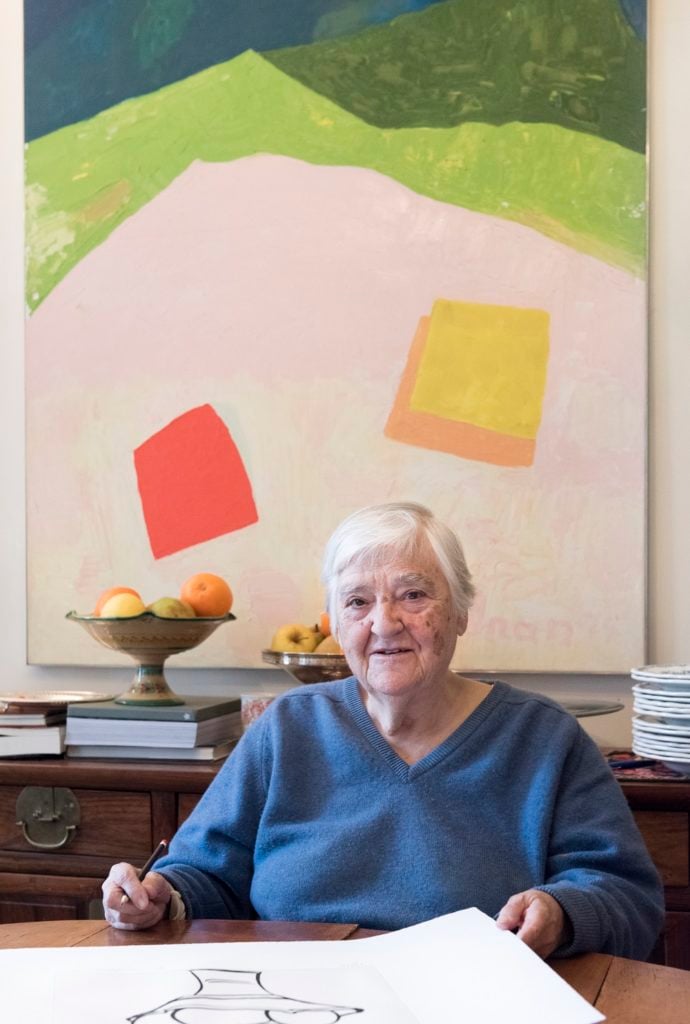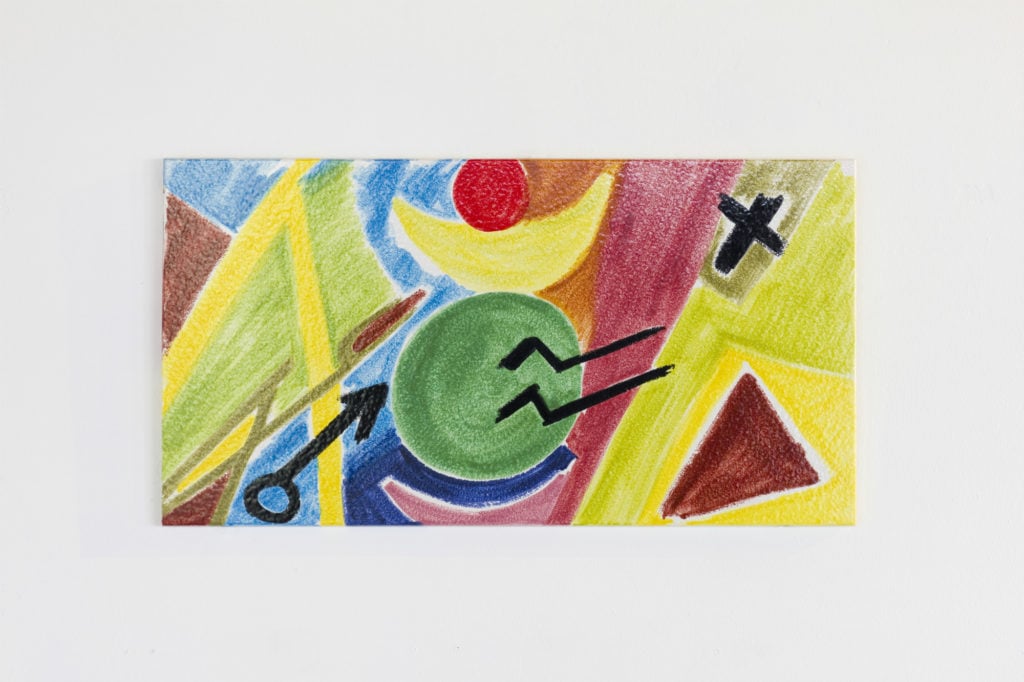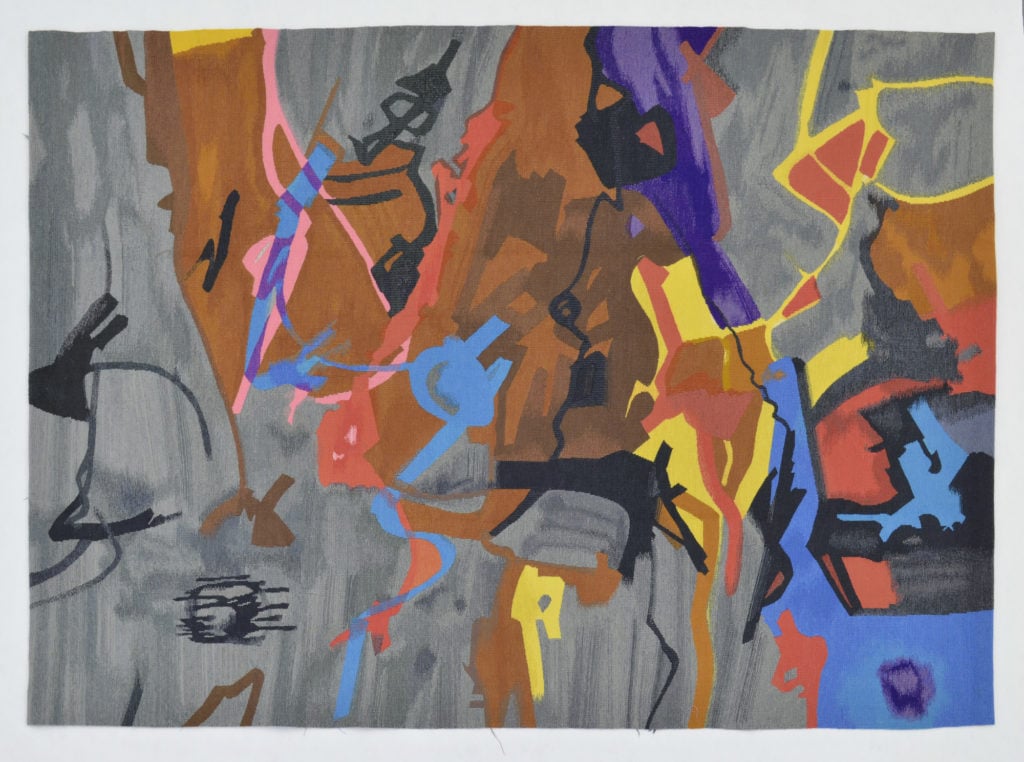Art & Exhibitions
Etel Adnan on Exhibiting With Gerhard Richter and the Politics of Landscape Painting
A new exhibition at The Flag Art Foundation brings the two giants together.

A new exhibition at The Flag Art Foundation brings the two giants together.

Emily Nathan

Although she can no longer travel due to her age, the effervescent nonagenarian poet, essayist, and artist Etel Adnan can still be found working, most days, in her 6th arrondissement apartment in Paris. Born in Beirut, and educated at the Sorbonne, UC Berkeley, and Harvard, Adnan has always embodied a multitude of perspectives. Her mother was a Greek from Smyrna; her father, an Ottoman officer born in Damascus; and although she moved back briefly to Beirut in 1972, just in time to witness the beginning of the Lebanese Civil War, she returned in 1976 to the place she considers her true home: California.
Adnan’s poetry, which she began writing in response to the Vietnam War while teaching philosophy at the Dominican University of California, has always been overtly political; but the small, vibrant paintings she began making in those same years, were always inspired by the California landscape. Though the two forms of expression—political activism and genre painting—may seem antipodal, Adnan insists that violence and nature are the two fundamental aspects of all her work—and of everything.
Despite her global renown in the realms of literature—her 1977 novel Sitt Marie Rose, which offers a critical look at the factors that contributed to the war in Lebanon, is considered a classic—the spare, striking beauty of her artworks was virtually unknown to the world until 2012, when she was included in Documenta 13. Since then, she has exhibited in institutions around the world, and is now represented by Sfeir-Semler gallery and Galerie Lelong. Her newest exhibition, opening on January 19 at the FLAG Art Foundation in New York and on view through May 13, places her works in painting, textile, and ceramic in conversation with those of another contemporary master, Gerhard Richter.
artnet News dropped in on Adnan in Paris to discuss the difference between palette knives and brushes, the politics involved in painting a mountain, and why her artworks are more like poetry than prose.
Your work is marked by its bold, vibrant colors and its almost graphic aesthetic: simple arrangements of simple shapes. How did your style develop?
For me, painting is color. Shape has to be there, of course, because where the color stops, it makes a shape. That’s unavoidable. But the purpose of art-making, for me, is a certain hunger for color. Once the color comes out of the tube, it’s at its most beautiful. So this love for color keeps me painting.
I often work with a palette knife, and that determines a bit what I can do. The tool you use, of course, both limits and helps you—if you use a brush or a palette knife, you will have different results. It’s like in music: If you play the violin or the flute, you won’t get the same sound, even if you’re the same musician. It’s the same with words; they limit you, but how can you write poetry without them?
Many of your paintings seem powerfully tied to a sense of place; you spent many years living in northern California, and Mount Tamalpais makes recurring cameos in your canvases.
To be honest, I was raised thinking that Paris was the center of the universe. The French nuns at my school taught us from a history book called La France dans le monde, or France in the World. So we thought, unless you were in Paris, you were nowhere. But I do not feel this anymore. My real home is either Sausalito or Beirut, where I was born, and I spent much of my life living in California. I remember that my windows there had a big view of Mount Tam. So in a way, Mount Tam forced itself on me—I couldn’t avoid it, and I got very attached to that. I wouldn’t say that all I ever painted was that mountain, far from it, but I would say that I am a California painter; California is my center of the world.

Etel Adnan, Untitled, model for Le Soleil amoureux de la lune (2014). Photo Rémi Lavalle, courtesy GALLERIA CONTINUA, San Gimignano / Beijing / Les Moulins / Habana.
You have described your art-making practice as a need. Can you explain this?
Why we do these things has to be mysterious to a point; you can’t explain that much. But yes, art for me becomes a need. It becomes compulsive; you don’t know really why you do it. It is a search for something, and to be honest, I think you don’t know what you’re searching for until you’ve done it. And then when it’s done, that search is gone. Like a mechanical rabbit, you never catch it but you’re always running after it. That’s why you make your next painting: there is something always unsaid, undone. And it’s also an expectation, a thrill, to know what will the next thing be. So the next painting scares you, because every time you paint it’s as if you started for the first time. Writers speak of the white page; an actor can speak of the empty space. We build then from one trace, one word, one stroke. Every time you start with that blank canvas in front of you, it’s both anguishing and exciting—it’s like everyday living in that way.
What is art? It’s just a form of expression, and there is something artistic in every person, which comes out maybe in their way of walking, or cooking or sleeping; everything is expression. We should not divinize the artist, make her some kind of special being separated from society. Artists are people; the only difference is that artists perhaps produce something more tangible in terms of expression. Art comes from the desire to get out of oneself, to reach. It is a dialogue by essence, even if you don’t know with whom you’re speaking. You don’t know who will like—no, who will get your painting. It’s more than liking. It’s who will talk with that painting, who will see things, even when they see things you never intended. Ideally, a person discovers oneself in front of a work of art. Maybe the best that art can do is help you find something in yourself that couldn’t have happened otherwise.
And yet when you are making an artwork, you can’t anticipate what someone you don’t know will be able to discover.
Up to a large degree, you don’t even know what YOU are doing! You know, what I like about art, which is part of the word, is the ambiguity. Everything is ambiguity. We always look for hard-shell answers, but in fact if there were hard-shell answers to most questions, then we would stop thinking. One of the reasons we do art, or art makes you do it, is to see better.

Etel Adnan, Feux d’Artifice (2014), original tapestry design by the artist 1967-70.
Your writing work is often overtly political. How does your painting fit in to your oeuvre in a larger sense?
Nature and politics are related in many ways. Politics is the condition of all human behavior, and it’s in everything we do or don’t do. Sometimes painting is directly political, like Guernica, or like the movement of poetry against the Vietnam war, which was highly political. Now, when I paint a mountain, is it also political? I think it is! If I affirm life, and the beauty of the world, in a way I am closer to the pacifists. I cannot love nature to such a point, and at the same time wish for an atomic war. So it’s political by implication. It has a political effect, as well, in the sense that it tells people to quiet down and look at the good side of life, not only to grumble. And art is political even when it’s not overt, because it embodies and captures and is shaped by a perspective; if I paint a mountain, that’s a choice—because there is violence in the world, but there is also peace in the world. My work is really a window on beauty, on rest.
For the show at the FLAG Art Foundation, were you involved in the curation?
No, no, we have to let the galleries do their work. I have my part and they have their own. They are professionals, and if you interfere, you jam them.
Is there something special that may be gained in seeing your paintings next to Richter’s?
I think it’s nice to have artists together, because they give life to each other. It’s like each one is a lamp, shining light on the other. I don’t know what will come out of this particular pairing; I can’t travel so I haven’t seen them together, that depends on the views. Certainly, though, if I saw them together, it will make me think something.
“Etel Adnan | Gerhard Richter” is on view at The Flag Art Foundation, New York, from January 19 – May 13, 2017.